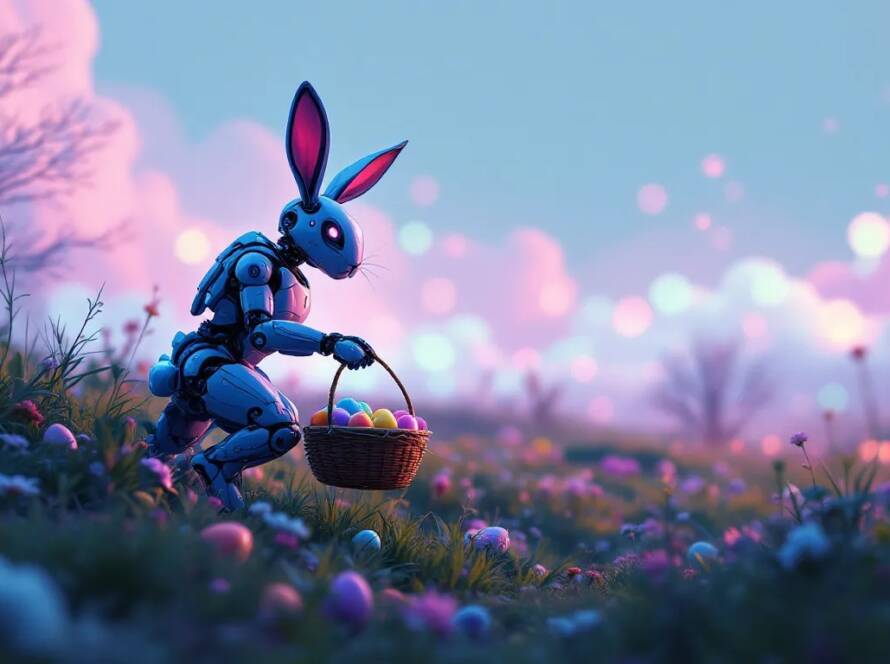Easter Symbols
When the Saxons converted to Christianity, their celebration became “Easter” to celebrate both the Spring and the religious Pascha times. Although many people think of these festivals, such as Easter and Christmas, as being only Christian, all the symbolism associated with them predates Christianity by thousands of years! The Jewish festival of the Passover (Pesach) is thought to have no connection with that of the Teautonic “Oestre”.
Bonfires & Candles
The Celts practiced a religion called Druidism. They believed in good and evil spirits. It was believed that the evil spirits captured the sun god and that was why there was winter. Every beginning of Spring, they would lit up huge bonfires to frighten away the evil spirits into releasing the sun. The lighting of bonfires are still a part of Easter celebrations in some countries today.
Today, bonfires represent the light coming to the world through Christ. The candle is also used as a symbol of the light of Christ.
Butterfly
The Butterfly is one of the significant symbols of Easter. Its whole life cycle is meant to symbolize the life of Jesus Christ. The first stage, is the caterpillar, which stands for his life on earth. The second phase begins from the cocoon stage, portraying the crucifixion and burial of Jesus. The third and final stage is the butterfly, representing his raising from the dead in a glorified body.
Dogwood
The dogwood is a spring-blooming tree. The Christian religion has adopted it as a symbol of the crucifixion of Christ. The legend says that a dogwood tree was used to make the cross of the crucifixion, and as a result, it now grows as a living memory of the event.
The crucifixion is said to be symbolized as follows:
- The Cross – represented by the four “petals” of the dogwood flowers, which form a cross.
- The Nails – the “petals” often have marks on the outer edge, said to be nail marks.
- The Crown of Thorns – the center of the flower can sometimes resemble a crown.
- The Blood – the red dogwood berries are said to represent the blood of Christ.
Easter Bonnet
An Easter Bonnet represents the tail-end of a tradition of wearing new clothes at Easter, in harmony with the renewal of the year and the promise of spiritual renewal and redemption. Irving Berlin fixed the “Easter bonnet” in popular culture, whose frame of reference was the Easter parade in New York City, a festive walkabout that made its way down Fifth Avenue from St. Patrick’s Cathedral.
Easter Bunny
As the spring festival and it’s imagery was passed from one generation to another, fanciful stories were woven around the original. One of which is that the goddess Eastre/Ostara transformed her pet bird into a hare, but the change was incomplete, the hare still laid eggs. The story was further embellished, by adding that these eggs were brightly coloured.
The hare were fertile animals and gave birth to many offsprings in spring. Therefore, the bunny served as a symbol of new life during the Spring season.
Easter Eggs & Spring Chicks
The “egg” and “spring chicks” were fertility symbols used by many people dating back many thousands of years. The egg was also crucial as a fertility symbol, and as people started keeping domestic fowl, such as chickens, the observation of hens’ eggs hatching, bringing forth yellow-colored chicks, was interpreted into their celebrations as the “sun” being reborn.
Today, an egg symbolizes the rock tomb out of which Christ emerged when he arose again. The chick, hatching out of the egg, symbolizes new life or rebirth.
Easter Lilies
In ancient Rome, people thought the goddess Flora made the flowers bloom. In ancient Greek, they believed that the goddess Demeter’s daughter was kidnapped while picking the flower. Only allowed to visit her mother during the spring and summer, they believed that Demeter’s happiness made the flowers bloom.
Today, the white blossoms symbolize the purity of Jesus. Lilies, emerging from the earth in the spring, also symbolize new life and the resurrection of Christ.
Hot Cross Buns
In ancient time, the two equinoxes were known as cross quarter days, as Spring was the start of their new year, they marked loaves with a cross (plus) sign to represent the four seasons of the year.
Today, hot cross buns have a cross of icing on the top to remind people of Christ.
Palm Branches
Palm branches, represents when Jesus arrived in Jerusalem on the first Palm Sunday and people waved palm branches, welcoming him. It was a Roman custom to welcome royalty by waving palm branches. Today, on Palm Sunday, Christians still carry palm branches in parades.
The Cross
The cross was a well-known symbol long before Christ. It was used as a special mark on clothes and buildings. However, when Jesus was crucified, the cross became a symbol of suffering. Then, with Christ’s resurrection, Christians saw it as a symbol of Jesus’s victory over death. In A.D. 325, Constantine at the Council of Nicaea issued a decree that the Cross is the official symbol of Christianity.
Jesus said, “For as Jonas was 3 days and 3 nights in the whale’s belly; so shall the Son of man be 3 days and 3 nights in the heart of the earth” (Mt 12:40).
Read More on The Easter Story as told in the Gospels.
The Lamb
The Easter lamb represents Jesus and relates his death to that of the lamb sacrificed on the first Passover. However, the lamb was often sacrificed as offerings to God by the Hebrews long before the first Passover. Christians traditionally refer to Jesus as “the Lamb of God.”



